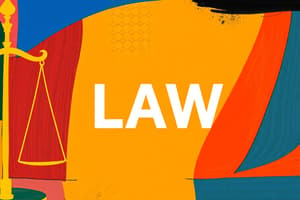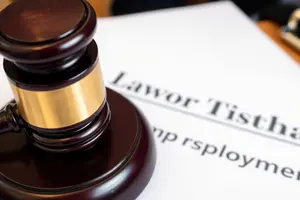Podcast
Questions and Answers
What are the four primary sources of US laws?
What are the four primary sources of US laws?
Constitutional, statutory, administrative, case law/common law doctrines
What do laws establish?
What do laws establish?
Rights, duties, and privileges
The U.S. Constitution is the supreme law of the land?
The U.S. Constitution is the supreme law of the land?
True (A)
What does statutory law include?
What does statutory law include?
What does administrative law include?
What does administrative law include?
What do case law and common law doctrines include?
What do case law and common law doctrines include?
What did the King's courts use?
What did the King's courts use?
What established common law tradition?
What established common law tradition?
What is the practice of deciding new cases based on precedent called?
What is the practice of deciding new cases based on precedent called?
A higher court's decision is a _____ on lower courts.
A higher court's decision is a _____ on lower courts.
Can you depart from precedent?
Can you depart from precedent?
Remedies ______ a right or _____ for injury.
Remedies ______ a right or _____ for injury.
What are remedies restricted to money or property called?
What are remedies restricted to money or property called?
What are remedies based on justice and fair dealing, when remedy at law inadequate called?
What are remedies based on justice and fair dealing, when remedy at law inadequate called?
What are the types of remedies in equity?
What are the types of remedies in equity?
Most courts today can award remedies in equity?
Most courts today can award remedies in equity?
What do equitable principles and maxims include?
What do equitable principles and maxims include?
A statute of limitation is the
A statute of limitation is the
What are laws that define and regulate rights and duties called?
What are laws that define and regulate rights and duties called?
What are laws that establish methods for enforcing and protecting rights called?
What are laws that establish methods for enforcing and protecting rights called?
What are private rights and duties called?
What are private rights and duties called?
What are public wrongs against society called?
What are public wrongs against society called?
What are the laws of a particular nation called?
What are the laws of a particular nation called?
What are the laws of observed nations called?
What are the laws of observed nations called?
Where can you find statutory or admin law?
Where can you find statutory or admin law?
Where can you find case law?
Where can you find case law?
What does a case citation include?
What does a case citation include?
Law comes from the
Law comes from the
Name methods of alternative dispute resolution
Name methods of alternative dispute resolution
What is the process by which a court decides on constitutionality of legislative enactments?
What is the process by which a court decides on constitutionality of legislative enactments?
What are the requirements to enter court?
What are the requirements to enter court?
What is jurisdiction?
What is jurisdiction?
What are the types of jurisdiction?
What are the types of jurisdiction?
Property can be
Property can be
Additional in rem includes
Additional in rem includes
Jurisdiction over subject matter include
Jurisdiction over subject matter include
Original vs appellate
Original vs appellate
Jurisdiction of federal courts
Jurisdiction of federal courts
What is the most appropriate physical location for the trial, where the injury occurred?
What is the most appropriate physical location for the trial, where the injury occurred?
What happens when a party has suffered a legal injury?
What happens when a party has suffered a legal injury?
Highest state court
Highest state court
Appellate courts can
Appellate courts can
Appellate courts include
Appellate courts include
To go to U.S. Supreme Court must have rule of
To go to U.S. Supreme Court must have rule of
Litigation process
Litigation process
Pleadings include
Pleadings include
Pre-trial motions
Pre-trial motions
Discovery includes
Discovery includes
Trial includes
Trial includes
Pre-trial motions include
Pre-trial motions include
Flashcards
Sources of US laws
Sources of US laws
constitutional, statutory, administrative, case law/common law doctrines
Purpose of laws
Purpose of laws
Establish rights, duties, and privileges.
U.S. Constitution
U.S. Constitution
The supreme law of the land.
Statutory law
Statutory law
Signup and view all the flashcards
Administrative law
Administrative law
Signup and view all the flashcards
Case law and common law
Case law and common law
Signup and view all the flashcards
Stare decisis
Stare decisis
Signup and view all the flashcards
Precedent
Precedent
Signup and view all the flashcards
Can courts depart from precedent?
Can courts depart from precedent?
Signup and view all the flashcards
Remedies at law
Remedies at law
Signup and view all the flashcards
Remedies in equity
Remedies in equity
Signup and view all the flashcards
Types of remedies in equity
Types of remedies in equity
Signup and view all the flashcards
Substantive law
Substantive law
Signup and view all the flashcards
Procedural law
Procedural law
Signup and view all the flashcards
Civil law
Civil law
Signup and view all the flashcards
Criminal law
Criminal law
Signup and view all the flashcards
Jurisdiction
Jurisdiction
Signup and view all the flashcards
Types of jurisdiction
Types of jurisdiction
Signup and view all the flashcards
Venue
Venue
Signup and view all the flashcards
Standing to sue
Standing to sue
Signup and view all the flashcards
Due process
Due process
Signup and view all the flashcards
Equal protection
Equal protection
Signup and view all the flashcards
Chevron deference
Chevron deference
Signup and view all the flashcards
Freedom of Information Act
Freedom of Information Act
Signup and view all the flashcards
Government in the Sunshine Act
Government in the Sunshine Act
Signup and view all the flashcards
Alternatives to litigation
Alternatives to litigation
Signup and view all the flashcards
Administrative Procedure Act (APA)
Administrative Procedure Act (APA)
Signup and view all the flashcards
Equal protection tests
Equal protection tests
Signup and view all the flashcards
Judicial review
Judicial review
Signup and view all the flashcards
Administrative law judges (ALJs)
Administrative law judges (ALJs)
Signup and view all the flashcards
Arbitration
Arbitration
Signup and view all the flashcards
Study Notes
US Law Sources & Types
- Four primary sources of U.S. law: constitutional, statutory, administrative, and case law/common law doctrines
- Laws establish rights, duties, and privileges
- U.S. Constitution is the supreme law of the land
- Statutory law includes federal/state legislation, local ordinances, and uniform laws
- Administrative law includes federal/state agencies
- Case law and common law doctrines include court rulings
- King's courts used precedent
- Common law tradition established by King's courts
- Stare decisis is the practice of deciding new cases based on precedent
- Higher court's decision is binding authority (precedent) on lower courts
- Precedent can be departed from when societal values change
- Remedies enforce a right or compensate for injury
Remedies & Types
- Remedies restricted to money or property are remedies at law
- Remedies based on justice and fairness (when remedies at law are inadequate) are remedies in equity
- Equity remedies include specific performance, injunctions, and rescission
- Most courts today can award remedies in equity if a remedy at law is inadequate
- Equitable principles and maxims include laches (delay) and statutes of limitations
- Statute of limitations is the time limit for court action
- Substantive law defines and regulates rights and duties, while procedural law establishes methods for enforcing them
- Civil law concerns private rights and duties, and criminal law concerns public wrongs against society
- National law pertains to a particular nation, and international law encompasses observed nations' laws
Finding and Understanding Law
- Statutory or administrative law found in U.S. Code (USC), state codes, and administrative rules (CFR)
- Case law found in regional/national legal reporters (e.g., West Group)
- Case citation includes parties, location of the case, and the deciding court
- Courts' decisions (majority or dissent) form the basis of the law
- Alternative dispute resolution methods: negotiation, mediation, and arbitration
- Judicial review is the process of determining the constitutionality of legislative acts
- Requirements to enter court: jurisdiction, venue, and standing to sue
Jurisdiction, Venue, and Standing
- Jurisdiction is the court's power to decide a matter
- Types of jurisdiction: in personam (over person), in rem (over property, real, personal, intangible)
- Long-arm statutes and corporate contacts expand in rem jurisdiction
- Subject matter jurisdiction: limited (probate, bankruptcy) or general (state trial court)
- Original vs. appellate jurisdiction: where a case begins and appeals are heard
- Federal court jurisdiction: federal question (federal law) and diversity jurisdiction (bias)
- Venue: appropriate location for a trial (where the injury occurred)
- Standing to sue: having suffered a legal injury
Appellate Courts & Litigation
- Highest state court's decision is final
- Appellate courts can affirm, modify, or reverse a lower court's decision
- Appellate courts hear cases without retrying them; only briefs are considered
- U.S. Supreme Court review requires a rule of four
- Litigation process: pleadings, pre-trial motions, discovery, pre-trial conference, jury selection, trial, post-trial motions, and appeals
- Pleadings include plaintiff's complaint, service/summons, and defendant's answer
- Pre-trial motions include motion for judgment on the pleadings and motion for summary judgment
- Discovery involves depositions, evidence, and electronic discovery
- Trial includes opening statements, plaintiff's case, defense, and closing arguments (could involve motions for a direct verdict)
- Post-trial motions include motion for judgment notwithstanding the verdict (JNOV) and motion for a new trial
- ADR (Alternate Dispute Resolution) settles 90% of cases and is typically cheaper
Ethical Considerations and Dispute Resolution
- Ethical decisions require justification, evaluation, discussion, decision-making, and inquiry.
- Ethical approaches include duty-based (religious) and outcome-based (cost/benefit analysis)
- Unreasonable goals can lead to unethical behavior
- Codes and whistleblowing mechanisms (sarbanes-oxley) ensure accountability
- Grease payments are permissible and legal (facilitate bureaucratic processes)
U.S. Government Structure & Powers
- U.S. government structure: legislative, executive, and judicial branches
- Legislative branch writes laws (veto/judicial review by other branches)
- Executive branch enforces laws (senate approves treaties/supreme court can declare uncon.)
- Judicial branch declares laws/actions unconstitutional
- Commerce clause is the most important constitutional power for businesses. It applies to virtually all commercial transactions.
- Dormant commerce clause: national government has exclusive power to regulate interstate commerce. State/federal laws with direct conflict, state law is invalid
- Preemption: When Congress chooses to act exclusively in a concurrent area
Constitutional Rights
- First Amendment includes freedom of speech and religion
- Freedom of speech is not absolute and has exceptions (content-neutral, fighting words, certain social problems, content-specific)
- Unprotected speech includes defamatory, threatening, fighting words, and obscene speech
- Establishment clause prevents government establishment of religion
- Free exercise clause protects religious freedom
- Due process (Fifth/Fourteenth Amendments) ensures fair treatment
- Types of due process: procedural (notice, hearing) and substantive (content of right)
- Equal protection (Fourteenth Amendment) ensures similar treatment for similarly situated individuals
- Equal protection tests: strict, intermediate, and rational scrutiny
Administrative Law
- Federal administrative agencies created by enabling legislation passed by Congress
- Delegation doctrine: Congress's power to create federal agencies
- Agency powers have executive (veto power), legislative (give/take away power), and judicial oversight (appeals)
- Courts' review of agency decisions: standing to sue, exhaustion doctrine (all agency remedies must be utilized)
- Agency action is upheld unless arbitrary or capricious
- Test for arbitrary/capricious: unexplained policy changes, inappropriate factors, failing to consider relevant factors, or contrary decision to evidence
- APA (Administrative Procedure Act): rulemaking, investigation, adjudication powers for agencies
- APA rulemaking follows notice-and-comment procedure
- APA investigations include summoning witnesses and evidence
- APA adjudication process resolves disputes with administrative law judges
- Chevron deference allows courts to defer to agency interpretations in ambiguity
- Agencies accountable to public through freedom of information act, gov in sunshine act, and regulatory flexibility act
Studying That Suits You
Use AI to generate personalized quizzes and flashcards to suit your learning preferences.




